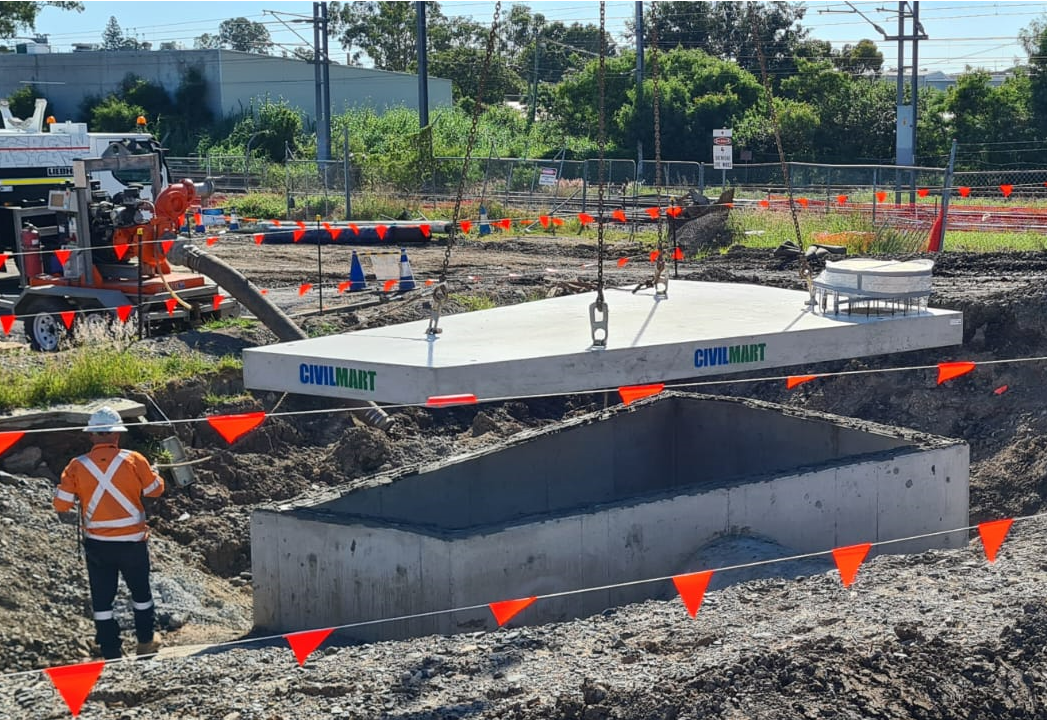A manhole is a ‘maintenance hole’, a hole in the ground that provides maintenance access to underground services and infrastructure. Keeping these holes – some of which can be very large – safe is crucial, and that’s where ‘maintenance hole’, or manhole, covers, come in. Although these important parts of underground infrastructure are often taken for granted, choosing the right manhole cover for the job is important because, essentially, people’s safety often depends on it. In this post, we provide you with all the information you need to choose the right manhole cover for your project – from types of manholes to mandated specifications, and their different applications.
What Are Manhole & Maintenance Covers?
Manhole covers are crucial when it comes to ensuring the safety and functionality of urban underground infrastructure like sewerage, groundwater drainage, telecommunication systems, and utilities. Their most obvious importance is that they stop vehicles and pedestrians from falling into what are often huge holes and tunnels in the ground. However, they’re also important for preventing unauthorised personnel, debris, and pests getting into these systems. Equally as importantly, they help prevent odours and air-borne bacteria leaking into the environment.
Further to these, manhole covers serve as:
- Entry points for maintenance crews who need access to clean, inspect, and maintain the infrastructure, or during emergencies.
- Drainage to assist with floodwater mitigation by allowing excess surface water to drain into underground sewer systems.
You could also say that manhole covers remove the need to install aboveground structures around these holes in the ground. That improves traffic flow, and reduces the safety hazards that such structures can pose to pedestrians and traffic. If you’ve experienced the inconvenience of having to walk or drive around even temporarily cordoned off areas because a manhole cover is open, you’ll understand the important of this!!
Types Of Manhole Covers
Manhole covers are made from precast concrete, steel and metal (i.e. cast iron), special composite materials, or plastics like high-density polyethylene. Each has its own pros, cons, and specific purpose. Choosing the right one comes down to location, use, and anticipated wear and tear.
Concrete & Precast concrete manhole covers
Concrete and precast concrete manhole covers are made from reinforced concrete. Our precast concrete manhole covers for instance provide exceptional strength and durability. Made from high quality precast concrete, they have a high load-bearing capacity, are corrosion-resistant, wear-resistant, and rated to withstand even the toughest conditions for many decades. They’re also recyclable.
Composite manhole covers
Composite manhole covers are made from fibreglass-reinforced plastics (resins) with mineral fillers to add stiffness and impact resistance, plus additives such as UV stabilisers, fire retardants, and colour pigments. You’ll come across acronyms like FRP (fibre-reinforced plastic), GRP (glass-reinforced plastic), BMC (bulk moulding composites), and SMC (sheet moulding compounds). They’re all variations upon a theme; the differences usually come down to manufacturing processes and composition specs.
Composite manhole covers have a number of pros – they’re lightweight but durable, strong, corrosion-resistant, non-thermal, non-conductive and relatively low maintenance.
Plastic manhole covers
Plastic manhole covers are made from strong, lightweight, durable high-density polyethylene (HDPE). They’re cost-effective but not suitable for heavy-duty applications.
Factors to Consider When Choosing Manhole Covers
When choosing manhole covers consider size, shape, accessibility, safety, locking mechanisms, and other security features. Also, check with your local council as they may have regulations governing manhole installation and use.
Load-bearing capacity
Load ratings for manhole covers in Australia are regulated by AS3996 – 2006 Access Covers & Grates, which defines a series of load classes from A – G based on their typical use. You’ll therefore need to install one that carries the correct rating for the location.
- A rated covers – residential backyards, sidewalks with no vehicle access etc.
- B rated covers – low use, slow speed private residential roads, driveways, parks, and residential car parks.
- C rated covers – residential roads with slow speed limits, minor roads, and public car parks (5000 kg nominal wheel loading).
- D rated covers – major roads, freeway and motorway shoulders, loading docks, warehouses, and other traffic areas (8000 kg nominal wheel loading).
- E rated covers – freeway and motorway carriageways; suitable for all heavy vehicles (13,700kg nominal wheel loading),
- F rated covers – docks, wharfs, airport service roads and taxiways (heavy and high traffic volume 20,000kg nominal wheel loading),
- G rated covers – docks, wharfs, airport runways (heavy and high traffic volume 30,000kg nominal wheel loading)
Size and shape requirements
Manhole covers are usually round and come in standard sizes, but can be custom-made to suit a bespoke installation. There are several reasons for the shape:
- Round covers can’t fall into the hole
- They are easier to move because they can be rolled
- Round structures don’t have joining points so are structurally stronger and better able to withstand external pressures (important for underground installations).
When it comes to size (and shape – square and rectangular covers do exist), your manhole cover must correctly fit the inner dimensions of the hole (chamber) it’s covering. This is its ‘clear opening size’ and is measured across the diameter in millimetres. The size you require thus depends on the size of the chamber, and that in turn depends on its purpose, traffic load, and local regulations.
Covers can also be solid or recessed. Solid covers are visible when installed, while recessed covers have a space for concealing materials i.e. turf, paving, slabs, tiles. If your cover is located in your garden, or a residential swimming pool or domestic parking area for example, you may want a recessed one for aesthetic reasons. If using a recessed cover, factor in the thickness and weight of whatever fill you’ll be using when calculating the required depth of the recess AND the carrying load of the cover.
Material durability and corrosion resistance
Manhole covers need to be tough, durable and long lasting with good corrosion and UV resistance properties because they’re often exposed to moisture, chemicals, harsh environments, and sunlight. Of all the different types of covers available, precast concrete covers fit the bill particularly well in all respects, especially in high traffic, heavy-duty areas.
Locking mechanisms and security features
Covers in public areas should be lockable for both security and safety reasons as it prevents unauthorised access and accidental displacement. Look for covers that can be locked down with bolts or hinged/key-operated locks. Consider also security features like tamper-detection systems and tamper-proof screws.
Accessibility and safety considerations
As the primary purpose of a manhole and its cover is to allow access to infrastructure, it must be fit for purpose, easily accessible, and safe. Therefore, it must be:
- The right size for the chamber it covers,
- Easy to open and close with the correct equipment,
- Anti-slip if in an area where something or someone could slip on it,
- Equipped with warning signs if it could be a trip hazard (councils have been sued because someone tripped on an uneven sidewalk!)
Choosing the Right Manhole Cover for Different Applications
Different applications have different requirements for manhole covers based on:
- Mandated load rating,
- Safety,
- Durability,
- Drainage capacity,
- Environmental regulations,
- Aesthetic appeal
Residential areas and sidewalks
Load rating: Manhole covers in residential areas and sidewalks must be rated A – C depending on use.
Safety: Covers in areas accessible to pedestrians should have anti-slip surfaces.
Drainage: Should provide adequate stormwater drainage.
Aesthetic appeal: Consider using manhole covers that blend in with the surrounding environment to maintain an aesthetically pleasing appearance.
Highways and heavy traffic areas
Load rating: Manhole covers must be high-load bearing and rated D or E depending on location and required load bearing capacity.
Durability: Covers should be made of strong durable materials with good strength and impact resistance such as precast concrete, steel, or composite materials. They shouldn’t crack or buckle under pressure.
Drainage: Should provide adequate stormwater drainage.
Locking mechanisms: Should have secure locking systems to prevent unauthorised access or accidental displacement.
Industrial and commercial facilities
Load rating: Will depend on the type of facility and traffic weight and volume. Most warehouses and docks for example need covers that are rated D, F, or G.
Drainage: Should provide adequate stormwater drainage whilst also factoring in potential surface contaminants in the water.
Chemical resistance: If the manhole covers will be exposed to corrosive substances or chemicals, choose materials, like precast concrete, that are resistant to these.
Ease of maintenance: Covers in these areas can get very dirty so need to be easy to maintain and clean (precast concrete covers are a good choice).
Safety: Anti-slip surfaces will prevent people and machinery slipping on the cover.
Specialised applications (airports, wastewater treatment plants, etc.)
Load rating: Docks, wharfs, and airport covers must be rated F or G (20,000kg / 30,000kg nominal wheel loading respectively).
Drainage: Must provide adequate stormwater drainage.
Specific requirements: Specialised applications usually have specific requirements for manhole covers. They may need to be fire resistant (airports), prevent odours and air-borne gases from escaping (wastewater treatment plants), or have special pressure release valves (fuel tanks).
Compliance with regulations: Must meet the specific standards and regulations for the given application.
Environmental considerations: Evaluate the covers’ resistance to chemicals, contaminants, and other environmental factors present in specialised applications. Typically, covers for these applications must be tough, tensile, and extremely wear-resistant.
Why Choose Civilmart For Your Manhole Covers?
When it comes to reliable and high-quality, durable manhole covers, Civilmart is your ultimate choice. Our extensive range of industry compliant precast concrete manhole covers means we have the perfect solution for your specific requirements. Trust in our expertise and commitment to exceptional customer service. Visit our website or contact us today and we’ll help you find the perfect manhole cover for your needs.
Join the Civilmart family
Stay up to date with latest product releases, newest industry innovations and more!


